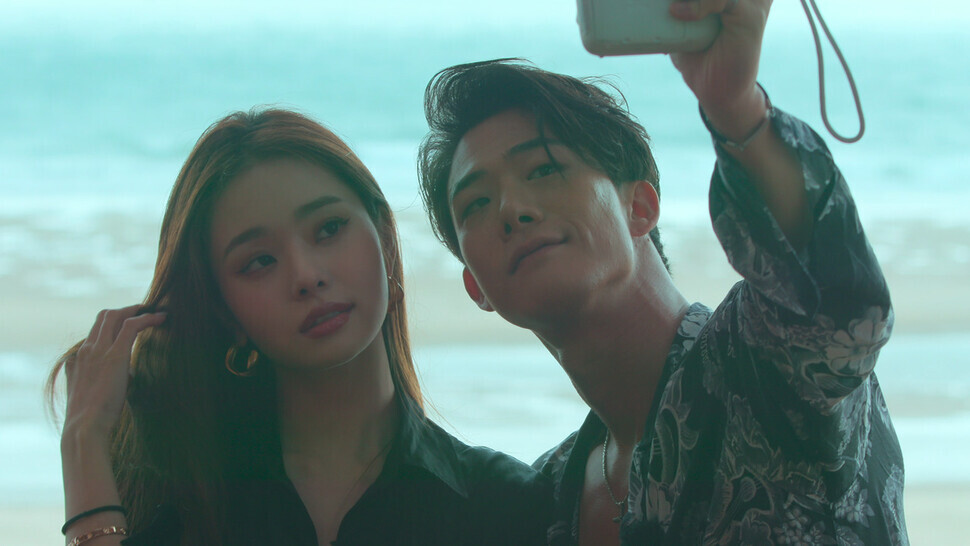hankyoreh
Links to other country sites 다른 나라 사이트 링크
“Single’s Inferno” and the unexpected wholesomeness of Korean dating shows

I remember hearing that the show was Korea’s answer to “Too Hot to Handle.” I couldn’t believe that even Netflix would have the nerve to make a show like “Too Hot to Handle” in Korea.
The US dating show, which Netflix released in 2020, was quite risque. It whisked away to a small island a group of men and women with the kind of chiseled bodies produced by eating no carbs and powering through three-hour workouts every day.
There’s one catch, though. To win the show, you have to abstain from all sexual relations. The moment the contestants heard this rule, they groaned as if someone had told them down was up. That’s America for you.
While Koreans may be more sexually open than they used to, I doubt that anyone here would agree to compete in a reality show like that. There wouldn’t be an audience for it, either.

When “Singles Inferno” first came out, it actually reassured me that a show like “Too Hot to Handle” could never be made in a place like Korea, with its Confucian background. The show wasn’t as radical as I’d feared.
Sure enough, there was a cohort of men and women with the kind of chiseled bodies produced by not eating carbs and powering through three-hour workouts every day. But there wasn’t any sex — nor any kissing, either. Guys and gals boasting bodacious bods sat down with unusual propriety and awkwardly exchanged greetings.
In general, it highly resembled “I am Solo,” a modified version of the “Jjak” dating show made by SBS, which aired from 2011-2014. In fact, the only difference between “I am Solo” and “Single’s Inferno” is the level of attractiveness of the participants. This is not to say there is anything wrong with how “I am Solo” contestants look — the two programs simply have different aims.

Korean dating shows have come a long way since the days of “Jjak.”
Dating shows that have been met with success over the past few years include Kakao TV's "Change Days" and Tving's "Transit Love.” These programs took a different approach than traditional dating shows that would put two strangers in a confined space and wait to see what unfolds.
“Change Days” shows couples contemplating separation while dating someone new at the same time. Meanwhile “Transit Love” reunites couples who have recently broken up to date new partners while hiding their past relationship status.
These shows represent a major shift for the Korean entertainment industry. In other countries, the most important component of dating shows is usually the sexual attractiveness and charm of the participants. Both “Change Days” and “Transit Love” modify the format of older Korean reality shows by limiting the participants to couples contemplating breakup or couples who have already broken up.
In Korean dating shows, what is important is not so much the participants’ sexual attractiveness but instead the relationship they develop mentally and emotionally with one another.
Both Kakao TV and Tving’s dating shows focus more on the inner conflicts that the participants deal with as they see new people. In Confucian Korea, this kind of emotional and mental tension is the strongest weapon a dating show has.

But “Single’s Inferno” tried to break away from this format. The cameras were constantly searching for the best angles to highlight the physical attractiveness of its participants. One of the visual climaxes of the show, for example, was when the female contestants couldn’t stop themselves from gawking at the perfectly sculpted bodies of the male counterparts wearing nothing but swimming trunks.
It’s akin to a flock of birds trying to seduce a group of females by performing an elaborate dance with their colorful feathers. I, too, admit to have gasped at some scenes while watching.
But a truly shocking scene came when one female contestant — lying in bed next to her male suitor — teased him, saying he probably wouldn’t be able to fall asleep because he was “too excited.” This marked a real turning point in the history of Korean dating shows.
I was actually ready to give the show a standing ovation if the scene had gone any further. But it didn’t.
The sexual tension in “Single’s Inferno” didn’t go beyond contestants lying in bed next to each other. In the end, it seems clear that both the producers and cast were well aware that this was indeed still a Korean dating show, where there is still that invisible line that mustn’t be crossed.

Still, there are many ways in which the hot contestants in “Single's Inferno” are quite similar to those in “I am Solo.” The most fun part about watching “Single's Inferno” was still the mental game of figuring out who likes who and who is just pretending to like one person but secretly likes someone else. In the end, the producers were able to make a dating show that remained very Korean at its core but that adopted a more Western format.
But then one last question remains. How was “Single's Inferno” able to climb to the top 10 of Netflix’s international rankings? While Korean viewers thought the show was so “hot” for Korean standards, American viewers voiced rather different opinions on review sites such as IMDb.
One viewer said, “Western [dating shows] are loud and trashy, which makes them hugely fun and cringy. This show is such a reveal of the difference in cultures.” They went on to say, “Not much happens in this show, and if you're looking for crazy entertainment, this isn't it. In many ways it's rather beautiful.”
Another viewer wrote: “Such an interesting look at a culture that simply doesn't exist in America. Gentle, kind, sweet and honest.”

“Single's Inferno” has become the new “Squid Game.” “Squid Game” hit it big by taking a Western genre and putting a Korean spin on it. The emotionally-laden moments that Korean viewers were so critical of were enjoyed by overseas viewers as a window into a culture different from their own. The sheer number of YouTube videos showing non-Korean viewers blubbering over the marbles “gganbu” episode of “Squid Game” can tell you as much as that.
The same goes for “Single's Inferno.” It’s similar and at the same time different from other, foreign, dating programs. Besides just focusing on the physical attractiveness of the contestants, the show focuses even more on trying to convey the exchange of emotions between the participants.
So in the end this show is actually about “Confucian boys” and “Confucian girls” — Korean neologisms describing young people whose modesty falls in line with traditional Confucian morality. It is modest. It would be quite ironic if this modesty indeed made the show into the “Squid Game” of Korean dating shows.
Given all this, I would like to suggest a tagline for the show’s next season: “Welcome to the K-Inferno: Soft, kind, sweet and honest!”
By Kim Do-hoon, former editor of the Huffington Post Korea
Please direct questions or comments to [english@hani.co.kr]

Editorial・opinion
![[Column] The state is back — but is it in business? [Column] The state is back — but is it in business?](https://flexible.img.hani.co.kr/flexible/normal/500/300/imgdb/original/2024/0506/8217149564092725.jpg) [Column] The state is back — but is it in business?
[Column] The state is back — but is it in business?![[Column] Life on our Trisolaris [Column] Life on our Trisolaris](https://flexible.img.hani.co.kr/flexible/normal/500/300/imgdb/original/2024/0505/4817148682278544.jpg) [Column] Life on our Trisolaris
[Column] Life on our Trisolaris- [Editorial] Penalties for airing allegations against Korea’s first lady endanger free press
- [Editorial] Yoon must halt procurement of SM-3 interceptor missiles
- [Guest essay] Maybe Korea’s rapid population decline is an opportunity, not a crisis
- [Column] Can Yoon steer diplomacy with Russia, China back on track?
- [Column] Season 2 of special prosecutor probe may be coming to Korea soon
- [Column] Park Geun-hye déjà vu in Yoon Suk-yeol
- [Editorial] New weight of N. Korea’s nuclear threats makes dialogue all the more urgent
- [Guest essay] The real reason Korea’s new right wants to dub Rhee a founding father
Most viewed articles
- 1[Column] Why Korea’s hard right is fated to lose
- 2Amid US-China clash, Korea must remember its failures in the 19th century, advises scholar
- 360% of young Koreans see no need to have kids after marriage
- 4[Column] The state is back — but is it in business?
- 5AI is catching up with humans at a ‘shocking’ rate
- 6Japan says it’s not pressuring Naver to sell Line, but Korean insiders say otherwise
- 7[Column] Can Yoon steer diplomacy with Russia, China back on track?
- 8Hybe-Ador dispute shines light on pervasive issues behind K-pop’s tidy facade
- 9Presidential office warns of veto in response to opposition passing special counsel probe act
- 10Gangnam murderer says he killed “because women have always ignored me”